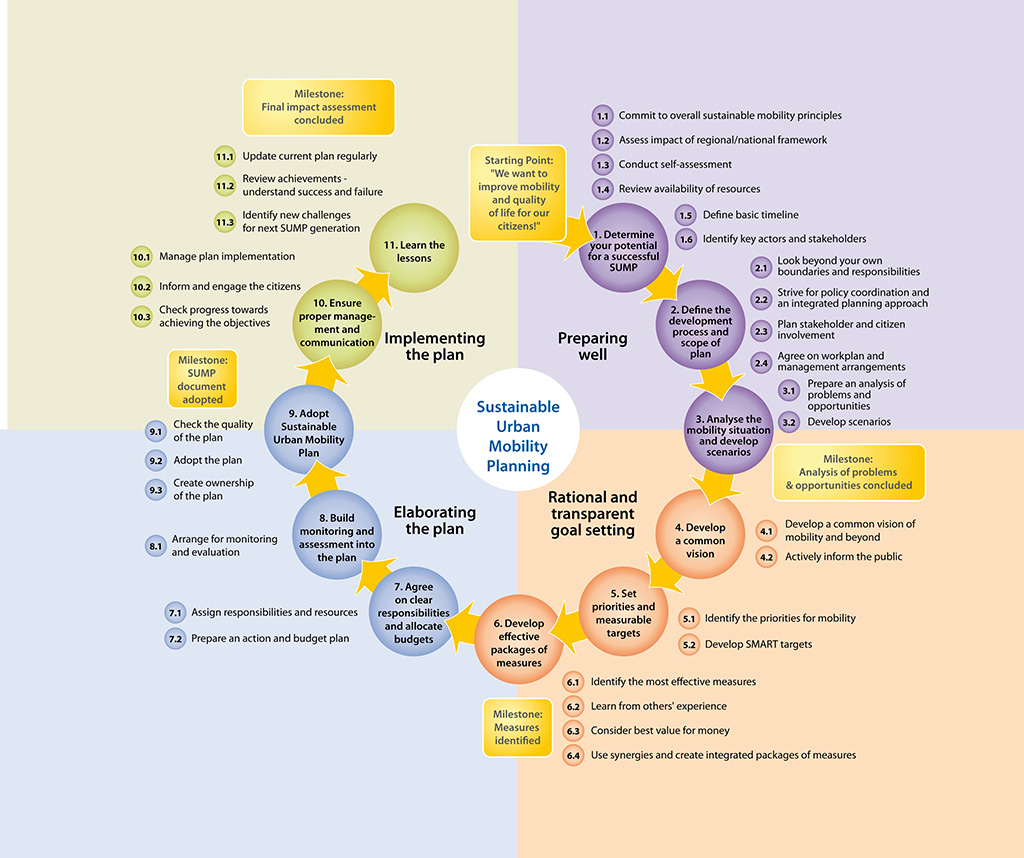The steps :

According to ELTIS's general design principles, the process of developing a SUMP consists of 11 Steps organized in 4 Phases.
-
Determining the Capabilities for a Successful SUMP At the beginning of the design process, it is necessary to determine the possibility of developing a successful SUMP. This depends on many external and internal factors that provide the overall framework for the planning process and implementation of the project.
-
Defining the Development Process and the Scope of the Plan
The design process for SUMP must be adapted to local conditions. This includes as a critical step the definition of the geographical scope, which should ideally look at the "functional urban area". Stakeholder cooperation and policy integration are two more areas that need to be addressed at this stage which ends with an agreement on work plan and management.
-
Analysis of Mobility Status and Scenario Development
The final step in the good preparation of the SUMP is the analysis of the existing mobility situation and the development of possible future scenarios. This is the basis for setting goals in a rational and transparent manner. As a first step, a thorough analysis of problems and opportunities in the field of urban transport and mobility is necessary. This action is an important milestone, as it feeds the development of different scenarios. These scenarios help to better understand how urban mobility might look like in the future.
-
Developing a Common Vision
The development of a common vision is one of the cornerstones of the Sustainable Urban Mobility Plan (SUMP). It is the common vision that will set the basis for defining the objectives and measures of a SUMP.
The vision can become the driver of an SUMP if it is widely accepted by both citizens and stakeholders.
-
Definition of Priorities and Measurable Targets
Vision is an important qualitative description for the future we want to have. But vision alone is not enough. It has to be determined by specific objectives, which indicate the type of change that society wants to have. These changes must also be measurable, so a selection of appropriate and studied goals that focus on selected areas is required.
-
Developing Effective Packs of Measures
The development of effective packages of measures is the core of sustainable urban mobility. Satisfaction with predetermined targets can only be ensured by appropriately selected measures. The choice of measures should be based on dialogue with the key stakeholders, take into account the experience of other regions with similar policies, ensure that the measures reflect the cost of their implementation and make the most of the synergies between the measures . Essentially, at this stage, the measures are defined as answers to the questions: what, how, where and when? Identifying measures (and package measures) is an important milestone in the development of the SUMP.
-
Agreement on Clear Competences and Funding Allocation
Closely linked to the choice of (package) measures is the definition of clear responsibilities as well as the preparation of a plan of action and budget. It is an essential part of the SUMP and requires the formal endorsement of all the parties involved. Essentially, in this step the questions need to be answered: who and how much?
-
Integrate Project Monitoring and Evaluation
Monitoring and evaluation should be included in the plan as key management tools to monitor the planning process and the implementation of the measures but also to help to draw on the experience of planning in order to consolidate what works well and what less well and to create specific cases on the basis of documentation on the wider application of such measures in the future.
-
Adoption of SUMP
The SUMP summarizes the results of all previous activities. After a final quality check, the document, including the actions and the draft budget, must be officially approved by the political representatives. It is also important to ensure that the project is widely accepted between stakeholders and citizens.
-
Ensuring Good Management and Communication (when implementing the project)
Once the Plan has been approved, the implementation phase begins. As the SUMP is a strategic plan, it provides a framework within which the actions of the SUMP must be implemented, but does not specify in detail how the various measures will be implemented. It should be stressed that the implementation process must follow a structured approach to improve the objectives and to design, specify, disseminate and control the implementation of the measures. These cyclical management processes will be much shorter in time compared to the design phase and should be flexible enough to adapt to new data. At the same time, an effort should be made to integrate within the framework of the agency responsible for implementing the measures.

